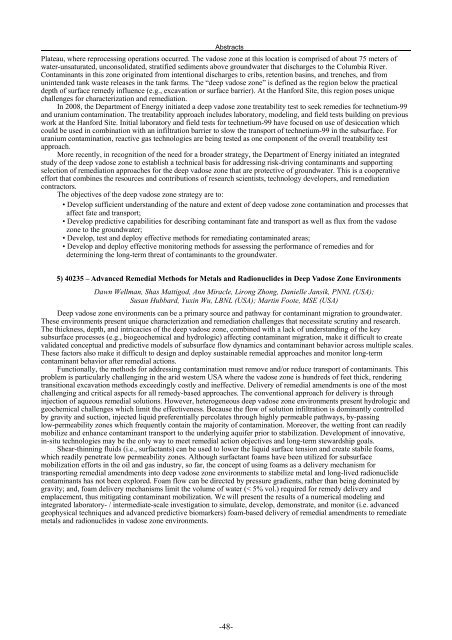ASME Message
ASME Message
ASME Message
Create successful ePaper yourself
Turn your PDF publications into a flip-book with our unique Google optimized e-Paper software.
Abstracts<br />
Plateau, where reprocessing operations occurred. The vadose zone at this location is comprised of about 75 meters of<br />
water-unsaturated, unconsolidated, stratified sediments above groundwater that discharges to the Columbia River.<br />
Contaminants in this zone originated from intentional discharges to cribs, retention basins, and trenches, and from<br />
unintended tank waste releases in the tank farms. The “deep vadose zone” is defined as the region below the practical<br />
depth of surface remedy influence (e.g., excavation or surface barrier). At the Hanford Site, this region poses unique<br />
challenges for characterization and remediation.<br />
In 2008, the Department of Energy initiated a deep vadose zone treatability test to seek remedies for technetium-99<br />
and uranium contamination. The treatability approach includes laboratory, modeling, and field tests building on previous<br />
work at the Hanford Site. Initial laboratory and field tests for technetium-99 have focused on use of desiccation which<br />
could be used in combination with an infiltration barrier to slow the transport of technetium-99 in the subsurface. For<br />
uranium contamination, reactive gas technologies are being tested as one component of the overall treatability test<br />
approach.<br />
More recently, in recognition of the need for a broader strategy, the Department of Energy initiated an integrated<br />
study of the deep vadose zone to establish a technical basis for addressing risk-driving contaminants and supporting<br />
selection of remediation approaches for the deep vadose zone that are protective of groundwater. This is a cooperative<br />
effort that combines the resources and contributions of research scientists, technology developers, and remediation<br />
contractors.<br />
The objectives of the deep vadose zone strategy are to:<br />
• Develop sufficient understanding of the nature and extent of deep vadose zone contamination and processes that<br />
affect fate and transport;<br />
• Develop predictive capabilities for describing contaminant fate and transport as well as flux from the vadose<br />
zone to the groundwater;<br />
• Develop, test and deploy effective methods for remediating contaminated areas;<br />
• Develop and deploy effective monitoring methods for assessing the performance of remedies and for<br />
determining the long-term threat of contaminants to the groundwater.<br />
5) 40235 – Advanced Remedial Methods for Metals and Radionuclides in Deep Vadose Zone Environments<br />
Dawn Wellman, Shas Mattigod, Ann Miracle, Lirong Zhong, Danielle Jansik, PNNL (USA);<br />
Susan Hubbard, Yuxin Wu, LBNL (USA); Martin Foote, MSE (USA)<br />
Deep vadose zone environments can be a primary source and pathway for contaminant migration to groundwater.<br />
These environments present unique characterization and remediation challenges that necessitate scrutiny and research.<br />
The thickness, depth, and intricacies of the deep vadose zone, combined with a lack of understanding of the key<br />
subsurface processes (e.g., biogeochemical and hydrologic) affecting contaminant migration, make it difficult to create<br />
validated conceptual and predictive models of subsurface flow dynamics and contaminant behavior across multiple scales.<br />
These factors also make it difficult to design and deploy sustainable remedial approaches and monitor long-term<br />
contaminant behavior after remedial actions.<br />
Functionally, the methods for addressing contamination must remove and/or reduce transport of contaminants. This<br />
problem is particularly challenging in the arid western USA where the vadose zone is hundreds of feet thick, rendering<br />
transitional excavation methods exceedingly costly and ineffective. Delivery of remedial amendments is one of the most<br />
challenging and critical aspects for all remedy-based approaches. The conventional approach for delivery is through<br />
injection of aqueous remedial solutions. However, heterogeneous deep vadose zone environments present hydrologic and<br />
geochemical challenges which limit the effectiveness. Because the flow of solution infiltration is dominantly controlled<br />
by gravity and suction, injected liquid preferentially percolates through highly permeable pathways, by-passing<br />
low-permeability zones which frequently contain the majority of contamination. Moreover, the wetting front can readily<br />
mobilize and enhance contaminant transport to the underlying aquifer prior to stabilization. Development of innovative,<br />
in-situ technologies may be the only way to meet remedial action objectives and long-term stewardship goals.<br />
Shear-thinning fluids (i.e., surfactants) can be used to lower the liquid surface tension and create stabile foams,<br />
which readily penetrate low permeability zones. Although surfactant foams have been utilized for subsurface<br />
mobilization efforts in the oil and gas industry, so far, the concept of using foams as a delivery mechanism for<br />
transporting remedial amendments into deep vadose zone environments to stabilize metal and long-lived radionuclide<br />
contaminants has not been explored. Foam flow can be directed by pressure gradients, rather than being dominated by<br />
gravity; and, foam delivery mechanisms limit the volume of water (< 5% vol.) required for remedy delivery and<br />
emplacement, thus mitigating contaminant mobilization. We will present the results of a numerical modeling and<br />
integrated laboratory- / intermediate-scale investigation to simulate, develop, demonstrate, and monitor (i.e. advanced<br />
geophysical techniques and advanced predictive biomarkers) foam-based delivery of remedial amendments to remediate<br />
metals and radionuclides in vadose zone environments.<br />
-48-


